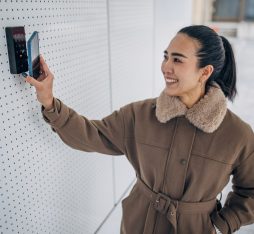5G has ushered in the “augmented technician” era. Tested across a range of business sectors, this experiment involves providing a technician with a pair of augmented reality glasses that are designed to use 5G to support them in their role, as well as to expand the size and scope of the work carried out. Engie has signed the first co-innovation agreement meaning that its technicians will have their work supported by remote expert assistance.
Remote Expertise Through Glasses
Technicians can call upon a remote expert to guide them through complex jobs. They are given smart glasses (with an HD camera) that are linked to a dedicated app on their 5G smartphone called “Mon Intervention dans ma Poche” (“My Job in my Pocket”). Experts can be consulted via a conference portal on the app, and the camera and 5G technology means they can see what the technician is seeing in real time, with no delays. The experts can then provide assistance and advice using visual indications, as these gestures are immediately shown in the technician’s field of vision.
Augmented technicians are already a reality, and the experience is now being enhanced by blockchain building blocks with new features.
This solution showcases how augmented reality can be used in professional contexts, as well as the strength of 5G. Orange is developing this solution in partnership with AMA, a specialist in assisted reality and interactive remote collaboration. To enhance the experience of both technicians and experts, Orange is integrating new blockchain and IoT technology building blocks into the AMA service, which has already been rolled out and is currently operational.
Recordings Stored and Traced
The first usage scenario to be explored focuses on “notarizing jobs,” which means recording and authenticating them as evidence in the event of a dispute, explains Philippe Delbary, Innovation Director in charge of Future of Work program. The video files are hosted on the Cloud and linked to a hash — a unique security key or signature — stored on the Archipels blockchain platform, a new member of Alliance Blockchain France (ABF). Generated at source, this reference hash confirms the authenticity and integrity of the file and, by extension, the job carried out. If even one pixel of the video changes, the hash changes too. This means a comparison can be made to determine whether the file is corrupted. The service was initially developed and tested on the Archipels private blockchain, as part of a partnership with Engie. It is likely that it will eventually interface with other platforms, such as the future ABF open blockchain platform, co-created by Orange and Docaposte.
Other Uses Being Studied
Notarizing is the first example of how blockchain technology can contribute specifically to jobs carried out by technicians. Other applications could follow. Orange Research teams are working on an extension to this solution that focuses on delegating responsibility. This would mean removing the restrictions that subcontractor technicians sometimes face, which prevent them from taking action and can lead to the work being terminated before it is complete. “In this case, it would be possible for a remote expert to give permission to the technician in the form of a token registered on the blockchain and placed into the technician’s smartphone wallet, before the work is notarized.”
Another potential use is to link the work recordings, photos and report to the digital twin of the relevant machine. This helps to maintain a history of the work carried out by ensuring that information is not lost. It can also allow other technicians to practice complex procedures before carrying out the work on site.





